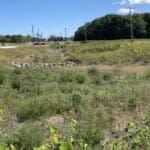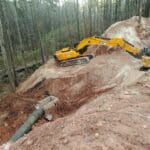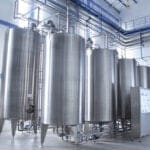The Board of County Commissioners (board), in order to properly protect the waters of Broward County, declares that the presence of pollutants, in excess of concentrations hereinafter provided, is harmful to the waters of the county and the presence of such concentrations is deemed to be prima facie evidence of pollution of the waters of Broward County and the same is expressly prohibited. The policy inherent in the standards shall be to protect water quality existing at the time these water quality standards were adopted or to upgrade or enhance water quality within the county. Where a new or increased source of pollution poses a possibility of degrading existing water quality, such project development shall not be issued a license until the applicant demonstrates that such development will not be detrimental to the best interests of the county and consistent with its social and economic development. Appropriate treatment shall be required as part of the initial project design to ensure that the quality of the receiving waters will be protected.
The board so finds and declares that, in order to protect the soils and waters of Broward County, it is necessary to provide for the management of water and related land resources; to promote the conservation, development and proper utilization of surface water and ground water; to ensure water storage and ground water recharge for beneficial purposes; to prevent damage from floods, soil erosion and excessive drainage; to prevent the degradation of the county’s drinking water supply from waterborne non-point-source and other sources of pollution and saltwater intrusion; to maintain the quality of water of natural habitats for the propagation and protection of terrestrial and aquatic flora and fauna; and to provide conditions necessary for continued recreational development.
Furthermore, it is the intent of the board, in adopting these regulations, to implement county-wide water resources planning and policy positions as they relate to regional and local water supply plans and ecosystem restoration projects, to establish a program which minimizes duplication of permitting and allows the board to seek delegation of certain domestic wastewater permitting authorization from the Florida Department of Environmental Protection (DEP) and surface water management permitting authorization from the South Florida Water Management District (SFWMD). The criteria contained herein are minimum criteria with the primary goal to meet county water resource objectives. Performance criteria are used whenever possible.
South Florida Water Management District
Stormwater Treatment Areas (STAs)
Every plant needs nutrients to survive and thrive, but South Florida’s native plants often are out-competed by other plants better able to use heavier nutrient loads. In constructed wetlands known as Stormwater Treatment Areas, some of these non-native plants with an appetite for high levels of nutrients are being used selectively to help remove excess nutrients, so that native plants can once again thrive.
Stormwater Treatment Areas, or STAs, are constructed wetlands that remove and store nutrients through plant growth and the accumulation of dead plant material that is slowly converted to a layer of peat soil. Five STAs south of Lake Okeechobee are now removing excess nutrients from agricultural runoff water and, in some cases, runoff from urban tributaries, before discharging it into the Everglades and other natural areas. Two more STAs north of Lake Okeechobee are now in the planning stage.
STAs are comprised of parcels of land with compartments or cells with different plants predominating in each cell. Emergent plants, like cattails, pickerel weed and bulrush, remove nutrients and store them in peat-like soils as they decay. Submerged plants, including hydrilla, southern naiad and chara, also take phosphorus directly from the water in STAs.
Urban Best Management Practices
Cities and communities also contribute nutrients and other pollutants to our region’s rivers, lakes and wetlands. Storm water flowing over city streets or the rich green lawns and gardens that fill our urban and suburban landscapes can carry excess nutrients from the fertilizers and herbicides we use, as well as all the other contaminants that are a by-product of modern life.
Local governments and developers are also required to adopt Stormwater Best Management Practices, or BMPs, that make sure that water flowing into our natural ecosystems is cleaner. These BMPs include keeping direct urban stormwater runoff away from waterways, retaining and cleaning stormwater or irrigation water “on-site” and reducing the amount of water used for irrigation, as well as the type and quantity of fertilizers and pesticides or herbicides used on our landscapes.
Additional Resources
South Florida Water Management District
S FL BMP Manual- Urban Stormwater
 Kenosha, Wis. Highway KR Regenerative Stormwater ConveyanceThe Root-Pike Watershed Initiative Network Kenosha County, and others worked with AQUALIS to design and implement an innovative solution for stormwater control along Highway KR.
Kenosha, Wis. Highway KR Regenerative Stormwater ConveyanceThe Root-Pike Watershed Initiative Network Kenosha County, and others worked with AQUALIS to design and implement an innovative solution for stormwater control along Highway KR. Durham, N.C. Sinkhole Leads to Stormwater System RehabilitationThe tenant on this property noticed a depression that opened to the ground below and notified the property owners.
Durham, N.C. Sinkhole Leads to Stormwater System RehabilitationThe tenant on this property noticed a depression that opened to the ground below and notified the property owners.
